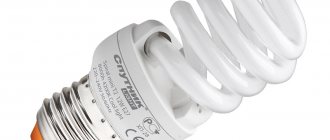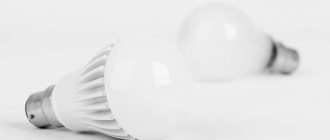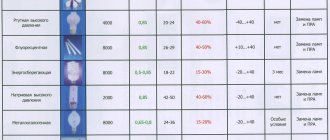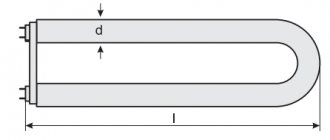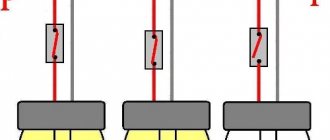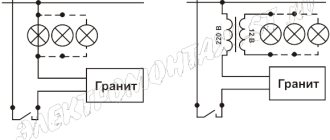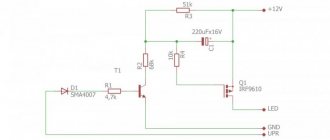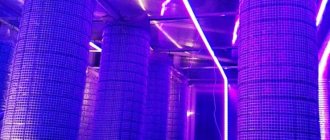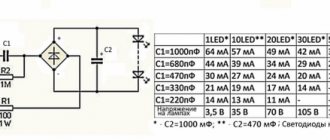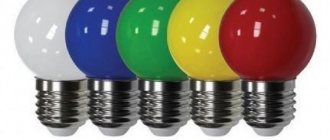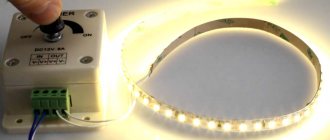What is an incandescent lamp? An electric incandescent lamp is a light source that is a very important item in human life. With its help, millions of people can get things done regardless of the time of day. At the same time, the device is very simple to implement: light is emitted by a special filament inside a glass vessel, from which the air has been evacuated, and in some cases replaced with a special gas. The filament is made of a conductor with a high melting point, which makes it possible to heat it with current until it glows visible.
General purpose incandescent lamp (230 V, 60 W, 720 lm, E27 base, overall height approx. 110 mm
What does the current power in the lamp depend on?
The lamp resistance does not depend on the applied voltage!
. Well, if we neglect the tiny change in resistance from heating the spiral, when the spiral is heated, its resistance increases greatly! It really depends on the metal! i.e. - the resistance of an incandescent lamp is nonlinear - at a small voltage it is small. and as it increases, it increases due to heating. .
There is such a value - temperature coefficient of resistance (TCR). For most metals (including tungsten, from which the filament of a lamp is made), the temperature coefficient of resistance is positive: their resistance increases with increasing temperature. Specifically for tungsten - with a resistivity of 5.5·10^-6 Ohm·cm, TKS=51·10^4. Thus, a cold filament has a minimum resistance, and when heated, it increases linearly in proportion to the increase in temperature... But I will not increase the tension on the thread! Why? Further:
Of course, the higher the voltage applied to the lamp, the higher the current passing through it, and the higher the resistance of the filament. An increasing filament resistance, in turn, leads to a decrease in current... and as a result, the dependence of the current through the lamp (and, accordingly, the temperature of the filament and its resistance) turns out to be nonlinear (logarithmic)...
Well, all that remains to be added is that the rated power of the lamp (and, accordingly, the current through the filament and its calculated resistance) are indicated only for the rated voltage of the lamp (indicated on the cylinder). The resistance of a cold thread (voltage is 0) is tens of times less.
Just for fun, try measuring the resistance of a cold lamp (Rx) with an ohmmeter, and using a well-known formula (without taking into account the above) calculate its estimated power at a voltage of 220 V. Now compare the result of the calculation and the declared power of the lamp (as well as the resistance calculated from this power in a heated state (Rн)). Isn't it a stunning difference?
If you don’t have an ohmmeter, here is the result of the calculation using the example of a 40W 220V lamp: Rx = 109 Ohm... Thus, at U=220V, the lamp power should be P=(U^2)/R=48400/109=444.03W (.) But in real life we have in the heated state Rн=(U^2)/P=48400/ 40 = 1210 Ohm, or 1.21 kOhm (!), i.e. the resistance of the cold and hot (at rated voltage) thread differs by more than 10 times.
Well, if you want to make sure that the dependence is logarithmic - LATR and an ammeter are in your hands, God help you (and a drum on your neck... ;-))
Source
Working principle of a light bulb
Working incandescent lamp
Heating of the LN during operation occurs due to the design features of the light source. It is precisely because of the strong heating during operation that the operating time of the lamps is significantly reduced, which makes them not so profitable today. In this case, due to heating of the filament, t0 of the flask itself increases.
The operating principle of the LN is based on the conversion of electrical energy that passes through the spiral threads into light radiation. In this case, the temperature of the heated thread can reach 2600-3000 oC.
Note! The melting point for tungsten, from which the spiral threads are made, is 3200-3400 °C. As we can see, normally the heating temperature of the filament cannot lead to the beginning of the melting process.
The spectrum of lamps with this structure differs markedly from the spectrum of daylight. For such a lamp, the spectrum of emitted light will be characterized by a predominance of red and yellow rays.
It is worth noting that the flasks of more modern LN (halogen) models are not evacuated, and also do not contain a spiral thread. Instead, inert gases (argon, nitrogen, krypton, xenon and argon) are pumped into the flask. Such design improvements led to the fact that the heating temperature of the flask during operation decreased somewhat.
Incandescent lamp. Characteristics of incandescent lamps.
An incandescent lamp is an electric light source that emits a luminous flux as a result of the heating of a conductor made of refractory metal (tungsten). Tungsten has the highest melting point of all pure metals (3693 K). The filament is located in a glass flask filled with an inert gas (argon, krypton, nitrogen). The inert gas protects the filaments from oxidation. For low-power incandescent lamps (25 W), vacuum flasks are made that are not filled with inert gas. The glass bulb prevents the negative effects of atmospheric air on the tungsten filament.
To calculate the room illumination, you can use the room illumination calculator.
Table of LED lamps and incandescent lamps
Selecting the luminous flux of LED lamps based on the power of incandescent lamps is not as accurate as the first option, but it is much simpler, and many are accustomed to choosing light bulbs in this way. Let's look at the table of correspondence between LED lamps and incandescent lamps in terms of power and lumens:
| Power, Watt | Flow, Lm |
| 20 | 250 |
| 40 | 400 |
| 60 | 700 |
| 75 | 900 |
| 100 | 1200 |
| 150 | 1800 |
| 200 | 2500 |
| 250 | 3600 |
Do not forget that these values are approximate and not very accurate, but you can still use them as a guide. In the previous example, for our room of 30 square meters we needed a 1600 Lm lamp; previously we could have taken two 60 Watt incandescent lamps for such a room. The lighting will be a little less, but everything will fit together.
An even less accurate way to determine the luminous flux of an LED lamp is to compare its power consumption with the power of an incandescent lamp. Less accurate, because here the emitted light flux is influenced more by the quality of the diode than by energy consumption, but the connection is all there, so we can compare:
Types of incandescent lamps.
Incandescent lamps are divided into:
- Vacuum;
- Argon (nitrogen-argon);
- Krypton (+10% brightness from argon);
- Xenon (2 times brighter than argon);
- Halogen (composition I or Br, 2.5 times brighter than argon, long service life);
- Halogen with two flasks (improved halogen cycle due to better heating of the inner flask);
- Xenon-halogen (composition Xe + I or Br, up to 3 times brighter than argon);
- Xenon-halogen with IR reflector;
- Filament with a coating that converts infrared radiation into the visible range. (new)
Incandescent lamp - light output of fluorescent light bulbs in watts
The most familiar lighting device for us is an ordinary incandescent light bulb. It is a lighting source consisting of a glass bulb, an incandescent body, electrodes, a base and an insulator.
Nowadays, halogen incandescent lamps have become popular. They are simple, reliable, and can be purchased at a very low price. Despite the popularity of incandescent lamps, they have a number of disadvantages. The efficiency of such a device is about 2%, low light output within 20 Lm/W and a short service life of about 1000 hours.
Power of LED lamps for home equipment
To calculate, you will need such an indicator as illumination - the required light flux per 1 m², measured in lux. Thus: 1lx = 1lm x 1m².
The calculated standards are collected in the SNiP documentation, from which you can make an extract and find out the necessary lighting parameters for premises for various purposes.
In addition, the algorithm for calculating illumination allows you to divide the volume of the room into conditional zones where more intense or moderate light is needed and place the appropriate lighting fixtures in them.
Consequently, to equip the rooms you will need a certain number of lighting fixtures, with sources of a certain power. The ratio of economical LED lamps to the power of traditional light sources is given in the table:
The result of calculating the area multiplied by the required illumination in accordance with SNiP standards allows you to determine the power parameters of the required light sources in lumens and purchase the required number of devices.
The industry produces LED elements that do not require much effort when installing, developing and calculating a new circuit, but will provide optimal lighting both inside the house and in the garden, saving on utility bills.
Principle of operation
When connected to an electrical network, an incandescent lamp converts electrical energy into light by heating the filament. Made from refractory tungsten or its alloys, the filament is located in a glass flask filled with an inert gas or vacuum (for low-power lamps up to 25 W).
The flask serves to protect against external factors, and the inert gas (krypton, nitrogen, xenon, argon and their mixtures) does not allow the tungsten conductor to oxidize and reduces heat loss. The thread heats up under the influence of the current passing through it to a temperature of about 3000ºC (such a high temperature over time leads to thinning and burnout of the conductor).
As a result of heating, electromagnetic radiation occurs, a small proportion of which is in the visible spectrum, the main part is infrared radiation. Luminous flux occurs when the very high temperature of the filament converts electromagnetic radiation into visible light from the lamp.
The energy consumed by the lamp is partially converted into radiation visible to the eye. The main part, under the influence of convection inside the flask, is dissipated in the process of thermal conduction.
The light produced by incandescent lamps lies in the yellow and red spectrum and is therefore close to daylight.
Light bulb color
Color temperature (t0) is also an important indicator.
Color t0 is a characteristic of the intensity of light emitted by a light bulb and is a function of the wavelength defined for the optical range. This parameter is measured in kelvins (K).
Color temperature for incandescent lamp
It is worth noting that the color temperature for LN is approximately 2700 K (for light sources with a power of 5 to 60 W and above). Color t0 LN is in the red and thermal tint region of the visible spectrum.
Color t0 fully corresponds to the degree of heating of the tungsten filament, which prevents the FL from quickly failing.
Note! For other light sources (such as LED light bulbs), color temperature does not reflect how warm they are. With an LN heating parameter of 2700 K, the LED will warm up by only 80ºC.
Thus, the greater the power of the LN (from 5 to 60 W and higher), the greater the heating of the tungsten filament and the bulb itself will occur. Accordingly, the greater the color t0 will be. Below is a table where you can compare the efficiency and power consumption of different types of light bulbs. The control group with which comparison is being made here includes LNs with a power of 20 to 60 and up to 200 W.
Light flow
The direct purpose of any lighting device is lighting. In an incandescent lamp, it is created by converting thermal energy into luminous flux.
Definition and rules of measurement
Luminous flux is a quantity that characterizes the luminous power (light energy that is transferred through a certain surface per unit time by radiation) of visible radiation in the flow of this radiation, that is, according to the light sensation produced by the human eye.
The sensitivity of this sensation can be determined by the spectral efficiency curve, which is approved by the CIE. The unit of measurement of luminous flux in the International System of Units is lumen (lm or lm) , which is calculated by the formula:
1 lm = 1 cd*sr (1 lux × m2) , where:
- cd – candela;
- solid angle, 1 steradian.
The energy in a beam of light has a temporal and spatial distribution. Sources emitting luminous flux are distinguished by the distribution of spectral colors:
- line spectrum (individual lines);
- striped spectrum (nearby delimited lines);
- continuous spectrum.
The spectral density of a light beam is characterized by the distribution of the radiant flux over the spectrum. Measured in W/nm.
Correlation with element power
The increase in luminous flux directly depends on the power of the lamp. The graph (see figure below) shows a clear dependence of the increase in brightness in proportion to the increase in power.
Table - Dependence of the level of luminous flux and the power of an incandescent light bulb
| Incandescent lamp, W | Luminous flux (lm) | Lamp voltage, V |
| 40 | 610 | 12 |
| 40 | 570 | 36 |
| 40 | 340 | 230 |
| 40 | 400 | 240 |
| 60 | 955 | 36 |
| 60 | 735 | 225 |
| 60 | 645 | 230 |
| 60 | 711 | 235 |
| 60 | 670 | 240 |
| 75 | 940 | 220 |
| 75 | 960 | 225 |
| 100 | 1581 | 36 |
| 100 | 1381 | 225 |
| 100 | 1201 | 230 |
| 100 | 1361 | 235 |
| 150 | 2151 | 230 |
| 150 | 2181 | 240 |
| 200 | 2951 | 225 |
| 200 | 3051 | 230 |
| 300 | 3361 | 225 |
| 300 | 4801 | 230 |
| 300 | 4851 | 235 |
| 500 | 8401 | 220 |
| 750 | 13100 | 220 |
| 1000 | 18700 | 220 |
Incandescent lamps of the same power can emit different luminous fluxes. The higher the voltage, the higher the luminous flux value.
Comparison with other types of lamps
A comparative analysis of the luminous flux of incandescent lamps with more advanced fluorescent and LED lamps allows us to evaluate its effectiveness.
Correspondence table
LED lamps are superior to other types of lamps in the following key indicators:
- energy consumption;
- light output;
- heat generation;
- impact resistance;
- environmental friendliness;
- fire safety;
- service life.
Comparative characteristics of lamps by power
| Lamp type | Power in watts | |||||||||
| Incandescent | 25 | 40 | 50 | 60 | 75 | 100 | 120 | 150 | 200 | 250 |
| Halogen | 15 | 24 | 30 | 36 | 45 | 60 | 72 | 90 | 120 | 150 |
| Luminescent | 6 | 8 | 10 | 12 | 15 | 20 | 24 | 36 | 45 | 55 |
| LED | 2 | 4 | 6 | 8 | 10 | 12 | 18 | 22 | 26 | 30 |
| Light flux in lumens | 220 | 415 | 550 | 710 | 935 | 1340 | 1700 | 2160 | 3040 | 3900 |
The table shows that the energy consumption of LED products is the lowest, so lighting devices of this type are the most economical. How many lumens are in the lamp? This indicator depends on the power of the light bulb. The light flux in lumens is shown in the table.
The color of the luminous flux of LED products can be very different. It is determined by the chemical composition of the LED. Sometimes, for this purpose, different LEDs and light filters are installed in the lamp design, which makes it possible to obtain a glow in a wide range of the spectrum.
It is also customary to compare light bulbs according to the following indicators:
- degree of heating;
- anti-vandalism;
- service life.
During operation, incandescent and halogen lamps become very hot. It is known that a little more than 20% of the power is spent on lighting an incandescent light bulb, the rest goes to heating it. For halogen light bulbs, these figures are respectively 35 and 65%, for fluorescent light bulbs - 75 and 25%, and for LED light bulbs on average - 97 and 3%.
In terms of structural strength, incandescent and halogen lamps are the most fragile. LED bulb bulbs are made of impact-resistant material and can withstand falls from low heights. The situation is worse with fluorescent lamps, although their housing is much stronger than the housing of incandescent lamps, but from an environmental point of view, its destruction has a detrimental effect on health. Therefore, they must undergo special disposal.
And finally, the service life, which is usually indicated in hours. The palm belongs again to LED lighting devices. In practice, their service life ranges from 25 to 100 thousand hours and this depends on the production technology, the materials used and the manufacturer. Other types of light bulbs last much less, for example, incandescent lamps - 1 thousand hours, halogen lamps - 4 thousand hours, fluorescent lamps - no more than 10 thousand hours.
What is electric power
Any physical action is performed under the influence of force. With its help, a certain path is followed, that is, work is performed. In turn, the work A done during a certain time t will amount to the power value expressed by the formula: N = A/t (W = J/s). Another concept of power is related to the rate of energy conversion of a particular system. One of these transformations is the power of electric current, with the help of which many different works are also performed. First of all, it is associated with electric motors and other devices that perform useful actions.
Current power is related to several physical quantities at once. Voltage (U) represents the work required to move 1 coulomb. The current strength (I) corresponds to the number of coulombs passing in 1 second. Thus, the current multiplied by the voltage (I x U) corresponds to the total work done in 1 second. The resulting value will be the power of the electric current.
The given formula for current power shows that power is equally dependent on current and voltage. It follows that the same value of this parameter can be obtained due to high current and low voltage and, conversely, at high voltage and low current. This property makes it possible to transmit electricity over long distances from sources to consumers. During the transmission process, the current is converted using transformers installed at step-up and step-down substations.
There are two main types of electrical power - active and reactive. In the first case, there is an irreversible transformation of the power of electric current into mechanical, light, thermal and other types of energy. The unit of measurement used is the watt. 1W = 1V x 1A. In production and in everyday life, larger values are used - kilowatts and megawatts.
Reactive power refers to the electrical load that is created in devices due to inductive and capacitive oscillations of the energy of the electromagnetic field. In alternating current, this quantity is a product expressed by the following formula: Q = U x I x sin (angle). The sine of the angle means the phase shift between the operating current and the voltage drop. Q is reactive power, measured in Var - reactive volt-ampere. These calculations help to effectively solve the question of how to find the power of an electric current, and the formula that exists for this allows you to quickly perform calculations.
Both powers can be clearly seen using a simple example. Any electrical device is equipped with heating elements - heating elements and an electric motor. For the manufacture of heating elements, a material with high resistance is used, therefore, when current passes through it, all electrical energy is converted into thermal energy. This example very accurately characterizes active electrical power.
As for the electric motor, there is a copper winding inside it that has inductance, which, in turn, has the effect of self-induction. Thanks to this effect, a partial return of electricity back to the network occurs. The returned energy is characterized by a slight shift in voltage and current parameters, having a negative impact on the electrical network in the form of additional overloads.
Nuances when choosing a lamp
Light brightness
depends not only on the power of the lamp, but also on the material of the diffuser. For example, if you place a 100-watt lamp in identical fixtures with translucent and “solid” lampshades, the effect will be completely different. In the first case, there will be enough light, but in the second, you may have to buy two lamps or one, but of a completely different design.
In the photo: model BELL 95 from the Gervasoni factory, design by Startup Jasper.
Dull or bright? Decide in advance how bright the light should be in a particular area of the house. To do this, you need to make an approximate calculation. For example, if you like a pendant lamp with one socket for an incandescent lamp with an E14 base (“minion”), you must understand: the power of a light bulb of this type is minimal, and the light will be dim. For general lighting, such a model is not enough, even if we are talking about a bathroom. And vice versa, if you choose a 60x60 cm panel lamp for this room, it will give too much light, and it will simply be impossible to be in the bathroom: it’s too bright! In both described cases, it is impossible to replace the lamp with a more or less powerful one due to the design of the lamp.
What formula is used to calculate the power of electric current?
A correct and accurate solution to the question of what the power of an electric current is plays a decisive role in ensuring the safe operation of electrical wiring and preventing fires due to incorrectly selected cross-sections of wires and cables. The current power in an active circuit depends on the current and voltage. To measure current strength there is a device - an ammeter. However, it is not always possible to use this device, especially when the building design is just being drawn up and the electrical circuit simply does not exist. For such cases, a special calculation methodology is provided. The current strength can be determined by the formula given the values of power, network voltage and the nature of the load.
There is a formula for current power in relation to constant values of current and voltage: P = U x I. If there is a phase shift between current and voltage, another formula is used for calculations: P = U x I x cos φ. In addition, the power can be determined in advance by summing the power of all devices that are scheduled for commissioning and connection to the network. This data is available in technical data sheets and operating manuals for devices and equipment.
Thus, the formula for determining the power of electric current allows you to calculate the current strength for a single-phase network: I = P/(U x cos φ), where cos φ is the power factor. If there is a three-phase electrical network, the current strength is calculated using the same formula, only a phase coefficient of 1.73 is added to it: I = P/(1.73 x U x cos φ). The power factor depends entirely on the nature of the planned load. If you plan to use only lighting lamps or heating devices, then it will be one.
If there are reactive components in active loads, the power factor is already considered to be 0.95. This factor must be taken into account depending on what type of electrical wiring is used. If the devices and equipment have a sufficiently high power, then the coefficient will be 0.8. This applies to welding machines, electric motors and other similar devices.
For calculations in the presence of single-phase current, the voltage value is assumed to be 220 volts. If three-phase current is present, the design voltage will be 380 volts. However, in order to obtain the most accurate results, it is necessary to use in the calculations the actual voltage value measured with special instruments.

